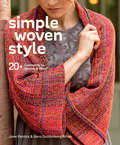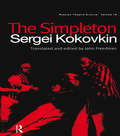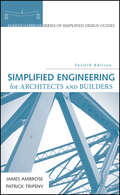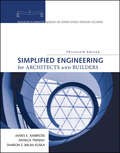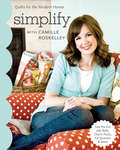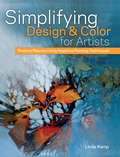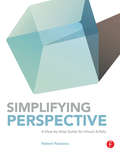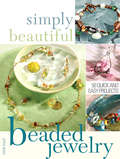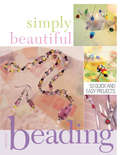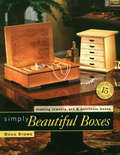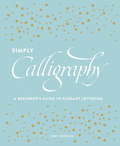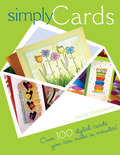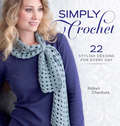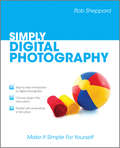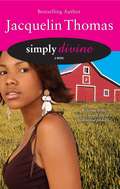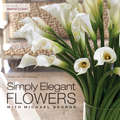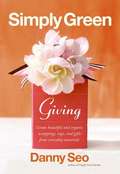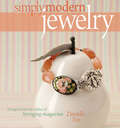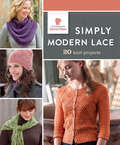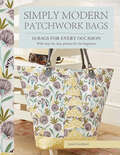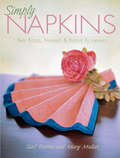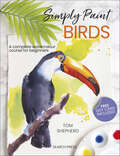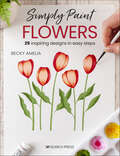- Table View
- List View
Simple Woven Garments: 20+ Projects to Weave & Wear
by Jane Patrick Sara GoldenbergFun and wearable weaving patterns!Simple Woven Garments is both a pattern book and an idea book for creating simple woven shapes and turning them into everyday, highly wearable fashions. Readers will enjoy classic woven styles and nods to today's style trends in a collection of 20 woven garments (and 4 variations) for the "what's next" weaver.This guide will help weavers create fabric that works for the intended garment, is easy to weave, and is above all beautiful. Authors Sara Goldenberg and Jane Patrick explore techniques such as yarn usage, spaced warps, felting, pick-up weaving patterns, finger-control weaving techniques, and embellishments. Shapes are simple rectangles and sewing requires minimal skill.Weavers will enjoy creating garments including wraps and tops, ranging from easy shawls with a twist to woven sweaters. Woven squares, rectangles, and strips are assembled into easy-sew garments with minimal finishing.
Simpleton The (Russian Theatre Archive Ser. #Vol. 19.)
by Sergei KokovkinFirst Published in 2000. Routledge is an imprint of Taylor & Francis, an informa company.
Simplified Engineering for Architects and Builders
by James Ambrose Patrick TripenyThe classic reference for structural design and construction--completely revised and updatedApproaching its eighth decade as the industry leader, Simplified Engineering for Architects and Builders remains the reference of choice for designers and constructors. This new Eleventh Edition is thoroughly revised and updated to reflect the latest practices in the design of structures.Long considered a standard in the field, this perennial bestseller provides a clear, accessible presentation of the engineering information that is essential for architects and builders. Offering a concise, highly readable introduction to the investigation and design of ordinary structures for buildings--including information on structural analysis, materials, and systems--this thoroughly updated Eleventh Edition includes:The latest building and material codesA fresh look at the LRFD method as well as the ASD method of structural designA revised section on the principles of structural mechanics for the latest generation of designers and buildersEssential formulas for the solution of structural problemsMore than 200 descriptive illustrationsA companion Web site that now provides access to the Study Guide to Accompany Simplified Engineering for Architects and BuildersAn unparalleled resource for students and professionals in architecture, construction, and civil engineering, Simplified Engineering for Architects and Builders, Eleventh Edition boils structural engineering down to its essentials and provides the simple design solutions that are used for the vast majority of buildings.
Simplified Engineering for Architects and Builders (Parker/Ambrose Series of Simplified Design Guides)
by James Ambrose Patrick Tripeny Sharon S. Baum KuskaThe gold-standard structural design reference, completely revised and updated with an all-new look Completely revised to reflect the latest standards and practices, Simplified Engineering for Architects and Builders, 13th Edition, is the go-to reference on structural design, giving architects and contractors a concise introduction to the structures commonly used for typical buildings. It presents primary concepts and calculations for the preliminary dimensioning of principal elements within a building design, focused on key principles of quantitative analysis and design of structural members. Structural design is an essential component of the architect’s repertoire, and engineering principles are at the foundation of every sound structure. Architects need to understand the physics without excess math. This book covers fundamental concepts like forces, loading, and reactions, to teach how to estimate critical design loads and analyze for final proportions. It provides exactly what you need to quickly grasp the concepts and determine the best solutions to difficult design challenges. The thirteenth edition of Simplified Engineering for Architects and Builders includes: Increased page size for improved visibility and usabilityNewly revised wood, steel, and concrete construction sections allow easy comparison of the latest techniques and materialsAccompanying instructor manual available online with background discussion, solutions to exercises, additional study materials, and self-tests A leading reference for over 80 years, Simplified Engineering for Architects and Builders is the definitive guide to practical structural design, ideal for students in architecture, construction, building technology, and architectural engineering.
Simplify with Camille Roskelley: Quilts for the Modern Home
by Camille RoskelleyLearn simple techniques for bringing hand-crafted style to your home in this guide to quilting with pre-cut jelly rolls, fat quarters, and more.In Simplify, quilter and fabric designer Camille Roskelley shares her pared-down approach to quilting that focuses on the essentials. She presents simple projects using gorgeous modern design and no-fuss fabric selection. Starting with a chapter on quilting basics, Camille offers easy-to-follow instructions for 14 projects, including pillows, table toppers, quilts, and more.
Simplifying Design & Color for Artists: Positive Results Using Negative Painting Techniques
by Linda KempWhen you become a better designer and colorist, you become a better painter. Painting doesn't have to be complicated to be good. In fact, it shouldn't be. Artist and best-selling author Linda Kemp (Watercolor Painting Outside the Lines) bypasses all the complexities of design and color to focus on a fresh, simplified strategy for success that features negative painting--a method that uses the space around your subject to help define it. Improve your painting step by step with projects and exercises that will help your work stand out from the crowd. With Simplifying Design & Color for Artists, you'll learn: Strategies for creating simple yet effective compositions, focusing on the relationship between shape, space, and color. Useful tips on color--how to simplify it, mix your own, and work with value, hue and intensity. Techniques for designing with shape: size and edge, layering, and building dimension and movement. 18 step-by-step projects in watercolor and acrylic. The approach may be simple, but your art will be spectacular!
Simplifying Perspective: A Step-by-Step Guide for Visual Artists
by Robert PastranaMaster the art of linear perspective. If you’re an animator, illustrator, comic book artist, game artist or anything in between, you need to be able to create images that accurately and realistically show space, dimension and form. Simplifying Perspective is the one and only guide that thoughtfully and clearly breaks down the principles of perspective into something that’s easy to understand and use. With approachable lessons and clear visual step-by-step instruction, Robert Pastrana provides you with powerful techniques that help you turn a troubled drawing into a living, breathing, dimensional scene. With Simplifying Perspective, you’ll never have to wade through dense, complex technical manuals again – this comprehensive guide to perspective is tailored specifically for artists who need to learn the ins and outs of one, two, and three-point perspective, measuring, shadows, reflections, and more. Simplifying Perspective presents complex drawing concepts in an easy-to-follow, approachable manner so you can finally learn the essentials of perspective without the anticipated frustration. Provides clarity, depth, and a wealth of examples – this is your must-have guide to understanding and using linear perspective Detailed visual instruction includes hundreds of color coded, step-by-step diagrams that allow you to easily follow the technical process of each construction Comprehensive companion website includes additional resources on perspective with a range of work to help further your skills
Simply Beaded Bliss: Adding Unique Elements to Classic Beaded Jewelry, Gifts and Cards
by Heidi BoydA Clever Twist on Simple StringingWashers, snaps, fishing tackle, resin: Nothing is safe with a crafty lady in the house. Get ready to break tradition and combine beads with common materials used in unconventional ways to make beautiful jewelry. You'll learn how to use nail polish to create the look of enamel, and how to link together cut-up credit cards into a playful bracelet. Or try mixing stainless steel washers with wire and beads to make surprisingly elegant jewelry. Before you know it, you'll be a true mixed-media jewelry artist.Bestselling author of the Simply Beautiful book series Heidi Boyd brings you more than 70 pretty beaded projects, all in her trademark classic style. Featured mixed-media elements include:WireFishing tackleNail polishWindow screenCredit cardsPolymer clayPaperCrystalsLeatherSequinsButtonsPlaying cardsSea glassGame piecesStart your adventures in mixed-media jewelry making today!
Simply Beautiful Beaded Jewelry: 50 Quick And Easy Projects
by Heidi BoydIf gorgeous beaded jewelry always catches your eye, you'll love making (and wearing!) your own necklaces, bracelets and earrings. Simply Beautiful Beaded Jewelryincludes 50 projects plus variations in designer Heidi Boyd's simply elegant signature style. Inside you're bound to find plenty of designs to strike your fancy as well as a helpful section that shows you the basic supplies and techniques you'll need to get started. As an added bonus, many of the projects have variations in different colors and styles to help you customize your jewelry to your personal style. Just think how proud you'll feel the first time you can answer, "I made it myself" to a compliment on your fabulous new multistrand necklace or your sparkling, swingy crystal earrings. WithSimply Beautiful Beaded Jewelry, it truly is easy to get started–in no time at all you'll be showcasing your own original beaded creations and making them as gifts.
Simply Beautiful Beading: 53 Quick and Easy Projects
by Heidi BoydBlend your creative spirit with the quick and easy projects found insideSimply Beautiful Beading From casual to sophisticated, and everything in between, you'll find beading designs to fit your personal style. Inside, you'll discover 53 simple yet stylish beading projects for exquisite jewelry, accessories and home decor, including: modern glass bead chokers semiprecious stone set charm bracelets wired-pearl barrettes wineglass charms hanging votive candle holder and more than 35 variation projects for even more simply beautiful ideas!
Simply Beautiful Boxes
by Doug StoweDoug Stowe's boxes are more than functional; they're inspired objects of beauty. Now you can recreate the same elegance in your own workshop with these 15 gorgeous boxes.Featuring a wide range of styles, these boxes embody the skill, artistry and innovation that has made Doug Stowe's work prized by collectors. From a simple ring box to an elaborate relief-carved jewelry box, you'll find, among others, these perfect pieces to suit your skills:Inlaid Walnut Ring BoxBracelet BoxLathe-Turned Ring BoxWedding Ring Music BoxWinter Woods BoxTriangle Ring BoxPin CabinetCherry Jewelry ChestTribute to American LindenReliquary & ReverenceTo help you craft each unique project, this guide includes step-by-step instruction, drawings, corresponding cutting lists, full-color photos and sidebars that detail the most difficult steps. Stowe also encourages you make each box your own by customizing his designs and selecting alternative woods and finishes.With Doug Stowe's guidance, you'll build more than boxes; you'll craft treasured heirlooms as precious as the objects you place inside of them. Take this guide and experience the satisfaction of creating simply beautiful boxes.
Simply Calligraphy: A Beginner's Guide to Elegant Lettering
by Judy DetrickThis little guide to hand lettering proves that calligraphy is as easy as picking up pen and paper. Focused on calligraphy's most popular alphabet--italic--this delightful manual introduces basic capital and small letters and numbers, plus all the creative flourishes you need to customize your unique script for every project and occasion. With quick and easy instruction from calligraphy teacher and designer Judy Detrick, Simply Calligraphy will have you whipping up elegant invitations, pleasing place cards, and personalized thank-you notes in no time.From the Trade Paperback edition.
Simply Cards: Over 100 Stylish Cards You Can Make in Minutes
by Sally TraidmanOver 100 stylish and fun handmade cards! You really can craft a handmade card in a matter of moments. It's simple with Simply Cards! Sally Traidman offers a wealth of beautifully designed cards that are easy to make, but hard to forget. With step-by-step illustrations, complete material lists and plenty of insider tips, you'll be crafting fabulous cards in no time at all!Using gorgeous papers, the latest inks and stamps and some of the coolest embellishments you'll find, these cards are a wonderful way to celebrate a special occasion, bring a bit of joy to everyday life, or send a holiday greeting. No experience is necessary with a quick-start guide and basic techniques.Let Simply Cards be your guide to creating quick and easy beautiful cards!
Simply Crochet: 22 Stylish Designs for Everyday
by Robyn ChachulaSimply Crochet allows you to crochet in more places and is your invitation to gorgeous crochet with a stash-busting twist!Robyn Chachula offers valuable designer advice and stylish crochet projects with a stash-busting twist in Simply Crochet. Robyn's enthusiasm for beautiful crochet coupled with her expert construction skills inspired this collection of patterns for crocheters looking to get maximum use out of their yarn. Inside you'll find 22 cleverly designed one, three, and five skein patterns for creating charming crocheted jewelry, scarves, bags, shawls, socks, vests, skirts, cardigans, jackets, home accessories, and baby friendly items. These patterns - from top designers including Carol Ventura, Tracie Barrett, Kristin Omdahl, and Doris Chan - will help you learn how to maximize the value of your yarn without compromising on style.Also included are designer tips on saving money and getting the most from your yarn stash. Robyn has outlined everything you need to know to decide which stitch choices and stitch patterns to choose in making your yarn go the furthest with any pattern. You'll also find creative ideas for up-cycling vests and tanks into tunics and pullovers with just an additional skein or two of yarn.Simply Crochet offers creative ideas and inventive solutions for resourceful crocheters of all skill levels looking for to get the most out of their yarn.
Simply Digital Photography
by Rob SheppardIf you are serious about digital photography, then this clear, concise guide is the ideal companion for fast and efficient learning.Simply Digital Photography offers techniques that can be used to make better digital photos, prints, and photo-based projects. Full-colour screen shots and numbered, step-by-step instructions show readers how to use their equipment, compose the best shot, and even make edits to photos to create stunning images and produce better photos.The simple, yet elegant design features a multitude of images as well as tips & tricks to make this a perfect reference for all ages - just follow the instructions with your camera and set your own speed.Packed with photos and illustrations, this visual tutorial is excellent value for money. Learn something new today - read it, try it and become your own expert with Simply Digital Photography!
Simply Divine
by ThomasTo forgive may be divine . . . The daughter of two Hollywood superstars, Divine Matthews-Hardison lives the privileged life most fifteen-year-olds only dream of: she's all about designer clothes, awards ceremonies, parties, and having a name that opens doors. Divine could be a model, an actress, anything she wants. But when you live in the spotlight, there's nowhere to hide when your family falls apart. Her father is in trouble with the law, her mother has her own demons, and no one has room for Divine -- no one except her uncle, a Georgia pastor with a modest country home and a big heart. . . . but can Divine ever forgive? Divine can't believe she's been sent to live with her mom's family in the sticks. Doing chores, getting an allowance, and church-going are hardly what she's used to, and she lets everyone -- from her patient Uncle Reed and Aunt Phoebe to her cousins, Alyssa and Chance -- know she's not trading in her Gucci bags for a feedbag any time soon. But as the love and faith of a good family take hold in her heart, miraculous changes start to occur. And when the chance comes to return to her high-flying life, Divine is faced with her toughest decision: Now that she's found the one thing she's never had, could she ever leave it behind?
Simply Elegant Flowers With Michael George
by Michael George Bob ShumanNew York's premier fashion industry florist, Michael George is known for his signature graphic, modern arrangements that are as popular in Manhattan hotels and storefronts as they are on the pages of Vogue and on the set of Good Morning America. In Simply Elegant Flowers, George shares his secrets for creating these beautiful arrangements as he guides you, season by season, through a year of flowers.George's philosophy of living and creating with flowers is contagious, and soon you'll agree that fresh, seasonal arrangements can enhance your life every day, not just on special occasions. His compositions recreate flowers as they are in nature—which, as he reminds us, is already perfect. Typically overlooked blooms, like carnations, take on a stunning new character when arranged en masse in a perfect dome, while more exotic stems, like dendrobium orchids, are at their most elegant when allowed to stand alone in a simple vase.Easy to follow, step-by-step instructions and photographs show you how to master George's techniques for building clean, contemporary floral compositions with his trademark architectural precision. Along the way, George shares helpful insights from a lifetime of working with flowers, and his recommendations of choice blooms for every season give you the confidence you need to begin creating your own unique arrangements, regardless of your budget. Beautiful photography brings the flowers to life on every page as he shows you how simple it is to apply these basic techniques to virtually any bloom. With Simply Elegant Flowers as your guide, you'll be arranging flowers like a professional—and displaying them like a celebrity.
Simply Green Giving
by Danny SeoDanny Seo's brand Simply Green is a way of living that embraces certain rules-Be Authentic, Be Resourceful, Be Simple, Be Unexpected, Be Truthful, and Be an Individual. In Simply Green: Giving Danny takes these goals and creates projects that are both thoughtful and sustainable while still being stylish and beautiful. The book has 50 quick and simple projects to create beautiful gift wrapping, tags, and handmade treasures from everyday materials. Projects include: Recycling oversized gift calendar pages turned into gift wrapping Old silk flowers reborn as stunning flowering bows Luxury store bags turned into personalized gift bags Jazzing up boring gift store cards Making organic soy treasure candles
Simply Modern Jewelry: Designs From The Editor Of Stringing Magazine
by Danielle FoxGeared toward the novice beader, this comprehensive introduction to making jewelry begins with "Bead Shopping 101" - a description of basic beads and how to differentiate between bead varieties and colors. Thirty projects are presented in a step-by-step manner with full-color illustrations to simplify techniques such as stringing, crimping, and the proper use of jump rings. All the designs reflect a modern sensibility for creating fashionable, boutique-quality jewelry.
Simply Modern Lace: 20 Knit Projects (Interweave Favorites)
by InterweaveHandpicked knitting projects celebrate a favorite topic for knitters--lace! Lace is a perennial favorite for knitters. Now the latest book from the Interweave Favorites series offers knitters a cornucopia of lace designs. Carefully chosen by Interweave editors, these standout projects featured in Simply Modern Lace will appeal to a broad range of knitters, from seasoned lace enthusiasts to those wanting to try a lace project for the first time. There are easy introductions to lace in the form of simple scarves, shawls, and hats. Readers may choose between easy shawls with just a border of lace or ones where lace takes center stage. Lace serves as a simple accent on feminine cardigans and pullovers or as an all-over design for true lace-lovers. A short primer on knitting lace, information on special cast-ons and bind-offs, and a discussion of how to handle shaping round out the book, making it more than just another "pretty lace." Simply Modern Lace celebrates a much-beloved technique, and readers will easily see why the featured knitting projects are indeed favorites at Interweave.
Simply Modern Patchwork Bags: 10 Bags For Every Occasion
by Janet GoddardThis step-by-step beginner’s guide show you how to make ten stylish bags—from shopping totes to classic clutches—with simply modern patchwork designs.Why have one bag when you can have ten? This easy-to-use guide lets you create fun yet practical bags for all occasions, whether it’s shopping, working, socializing, or celebrating a special occasion. Janet Goddard’s stylish designs feature fresh, bright fabrics with simple, stunning patchwork—a technique that combines multiple fabrics in various shaped pieces to create a unique pattern.With full color photos, step-by-step instructions, and Janet’s tips and techniques, this is an ideal guide for beginners looking to develop their sewing and patchwork skills.
Simply Napkins: Fast Folds, Finishes & Festive Flourishes
by Mary MulariNapkins - As Simple As Can Be No matter what your time, budget, or decor limitations, there's space in your life for these little squares of accessible elegance. Renowned design and sewing experts Gail Brown and Mary Mulari have put their heads together to bring you more than 25 napkin folds and dozens of napkin ideas for your table. Whether you want to sew your own napkins or fold ready-mades, you will find a treasury of ideas for making a personalized statement with your table decor. Create beautiful napkins using easy, popular techniques such as machine embroidery, stamping, stenciling, applique, and serging. Dozens of napkin-making and embellishment ideas - many no-sew More than 25 super-fast, no press napkin folds Instant innovations for using napkins as decor and gifts 300 color photographs and illustrations
Simply Paint Birds: A Complete Watercolour Course For Beginners
by Tom ShepherdUnlock the world of contemporary watercolour bird painting with popular artist and dynamic teacher, Tom Shepherd.Free Daniel Smith paint dot card included to get you started immediately!Painting birds doesn't have to be technical or daunting, even for a complete beginner. Through friendly advice and clear instructions, expert artist and tutor Tom Shepherd will show you how to paint 26 dynamic, colourful birds in 8 steps each, including:EaglesFlamingosOwlsMacaw parrotsRed CardinalsToucansRobins If you’re a complete beginner, simply follow the projects in order to learn how to handle watercolour in achievable, rewarding steps. You will build essential skills while producing impressive results right from the start. Meanwhile, if you’re a confident hobby artist, you can dip in and out wherever you wish.Tom's step-by-step process for each bird is simple and achievable, and uses just a few watercolour paints and a handful of brushes. His style is fresh and contemporary, and his clear instructions will allow you to achieve the same loose, dynamic results.
Simply Paint Flowers: 25 Inspiring Designs in Easy Steps
by Becky AmeliaBe amazed at how easily you can paint beautiful flowers in simple steps.Artist Becky Amelia shares her easy-to-follow approach to painting, with a range of beautiful flowers in her distinctive and contemporary style.Using only a few brushes and a small collection of watercolour and gouache paints, this book will inspire you with 25 stunning step-by-step projects to paint, including single flowers, leaves, wreaths and bouquets. Learn to paint sunflowers, tulips, poppies, lilies, wildflower arrangements, dried flowers and many more pretty stem arrangements.Feel inspired by Becky's intricate and delicate style and create beautiful floral paintings that you too could turn into gorgeous notecards, stationery, gifts or to keep as lovely, framed paintings.
Simply Redwork: Quilt and Stitch Redwork Embroidery Designs
by Mandy ShawMandy Shaw is well known for her distinctive sewing designs and motifs and in this book she brings her own style to the traditional and increasingly popular technique of redwork embroidery. You will learn how to create two quilts, the first has nine different heart-shaped quilt blocks, each with a different motif and theme, such as polar bears, scissors and honey bees. The second quilt is a variation which includes a nine patch block. Mandy then demonstrates how to use the different motifs to make up 12 simple projects such as pin-cushions, keyrings, hanging hearts and bags - ideal for sewers who don't want to tackle the full quilts. A helpful stitch guide with step illustrations will provide you with all the stitch techniques you will need, in addition, full-size templates for all the motifs are included together with a full alphabet enabling you to personalize your makes. Whether you're an experienced stitcher looking for inspiration or a novice sewer looking for new ideas, this title has something for everyone!
